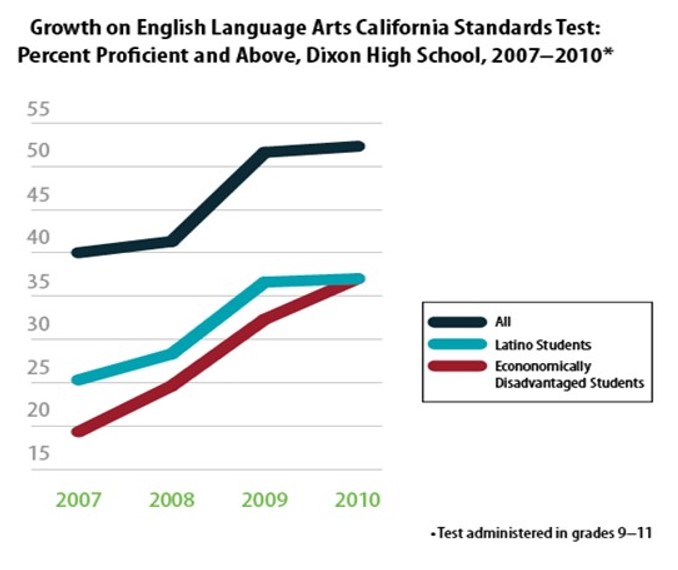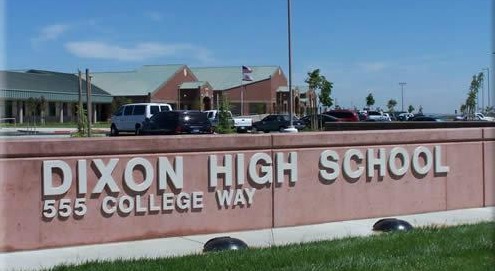Overview
Dixon High School – an ethnically, linguistically, and economically diverse school in California’s agricultural Sacramento area – was an early adopter of Reading Apprenticeship. Dixon’s dedicated teachers and students demonstrated that all students are capable of advanced work when given the right support by teachers who believe in them.
After a decade of implementation that began in 2000, Dixon achieved a remarkable transformation from a state-designated “underperforming school” to a “California Distinguished School.” Over the period of 2007-2010, students’ scores on the California Standards Test for English Language Arts increased by 31% overall with scores for Latino students increasing by 46% and scores for low-income students increasing by 92%. And in just one year, from 2009-2010, Dixon students gained 2.9 points on their Degrees of Reading Power (DRP) scores, compared to the expected 1.0 point.
Challenges
- Ensuring schoolwide implementation to reach diverse student population
- Supporting English learners in achieving high-level literacy
- Sustaining and building on initial success with continued teacher professional learning
- Building a culture of literacy; improving reading rates for all students
Implementation of Reading Apprenticeship
In their efforts to turn around school performance and improve student outcomes for college and career readiness, Dixon High embarked on schoolwide implementation of Reading Apprenticeship.
In their implementation of the Reading Apprenticeship instructional approach, Dixon High was determined to reach all subject area instructors in all levels, from English Learners to students struggling with low reading scores to AP students.
Dixon’s Advanced Placement course (AP) teachers, such as Gayle Cribb, used the Reading Apprenticeship framework with specific focus on augmenting the diversity of their classes. From the time she started teaching Honors U.S. History at Dixon High School, Cribb worked to increase the diversity of the class. As a result of her efforts, enrollment of Latino students rose dramatically. Many of the students in Cribb’s honors class are English learners or former English learners. All of them do the work of historians by grappling with primary sources, making text-based arguments, and helping each other think through reading challenges. And while most students in the class score at the two highest levels on the California Standards Test of English Language Arts, scores range from Basic to Advanced.
This video shows Cribb’s 11th grade honors class working with Reading Apprenticeship routines during a weeklong unit on the Japanese American internment. Focusing on the question of the constitutionality of the internment, students read several primary source documents, including the U.S. Constitution; opinions from Korematsu vs. United States, a 1944 Supreme Court case challenging the internment; and U.S. Department of Justice memos.
As students read, Gayle Cribb uses Reading Apprenticeship strategies to engage them in ongoing small group and whole class conversations about their reading and thinking processes. Through these discourse routines, Gayle’s Cribb’s students practice historical reading and thinking skills, gain stamina for challenging reading, and acquire deep knowledge of the history content.
- Standardized test scores over a year ahead of control students
- Significant impact on students’ reading comprehension scores – up to 63% improvement
- Substantial improvement in students’ grade point average in core academic classes
- Positive shifts in students’ identities as readers, problem-solvers and independent learners
- Statistically significant impact on student literacy in science classes
Results
In the school’s successful application for recognition as a “California Distinguished School,” staff at Dixon High cited the core, long-term role of Reading Apprenticeship in improving teacher practice and student outcomes:
“Before Dixon High School began implementing the Reading Apprenticeship model, all students, but particularly Latino and Economically Disadvantaged students, were underperforming. While Reading Apprenticeship is not the only program Dixon High School has implemented over the last decade, it is the most far-reaching in terms of duration and student exposure. Reading Apprenticeship permeates our academic curriculum, from humanities courses to the electives. Most teachers, regardless of field, see themselves as reading teachers and work diligently to help their students access complex and pertinent texts.”
Evidence from criterion-referenced and standardized tests supports the Distinguished Schools award. Degrees of Reading Power (DRP) scores, for example, weigh in at almost triple the increase expected from a year of instruction. In 2009–2010, Dixon students gained 2.9 points compared with an expected 1.0 point gain.
“For nearly the past decade, Reading Apprenticeship has enabled Dixon High School students to become more proficient and confident readers throughout their studies.”
—Dixon High School teacher
On the California Standards Test for English Language Arts, Dixon students’ scores have increased steadily, and achievement gaps are closing. As shown in the graph below, over the period 2007–2010, all students’ scores increased by 31 percent, scores for Latino students increased by 46 percent, and scores for low-income students increased by 92 percent. (Earlier standardized score gains at Dixon are reported in a three-year research study funded by The Carnegie Corporation of New York and the Walter S. Johnson Foundation.)
Dixon High’s steady, decade-long commitment to implementing and sustaining the Reading Apprenticeship model schoolwide is clearly resulting in a positive impact on student outcomes.

For more information about Reading Apprenticeship, contact us.

